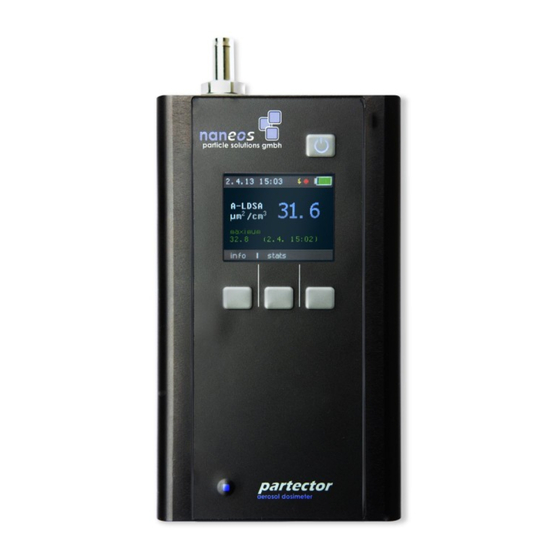Summary of Contents for Naneos PARTECTOR 2
- Page 1 Institute for Sensors and Electronics (FHNW/ISE) Handheld Emission Particle Counter (HEPaC) Operation Manual...
-
Page 2: Document Information
Document information FHNW/ISE, 2020 Related device versions: v 1.0 Related firmware versions: ≥ 137 Document version: 1.04 Document Date: 2021-05-27 Document change log Date Change 2020-02-20 Initial version Safety information (page 2) – “do not measure with charger connected…” 2020-03-11 2020-05-28 Additional changes for certification 2020-07-02... -
Page 3: Abbreviations And Definitions
Abbreviations and definitions Diffusion charging, diffusion charger diameter, number based geometrical average mobility diameter, geometrical standard deviation 1.4 …1.6 Efficiency High voltage Light-emitting diode Number concentration Safety information General notes and warnings This operation manual must be read completely before using the HEPaC. Incorrect use or handling and any consequences arising from this may damage the device or endan- ger personnel. -
Page 4: Instrument Specifications
Instrument specifications Measurements and accuracy Measured value: Particle number concentration N Concentration range : – 5 N: 10 pt/cm Efficiency E versus size: 23nm: E<50% 41nm: E>40% 80nm: 70% < E < 130% 200nm: E <150% 30nm Tetracontane (up to 10 ) E <... -
Page 5: Getting Started
Instrument description The HEPaC is a hand-held, battery powered instrument based on the partector2 by na- neos (naneos.ch) to measure the number concentration of nanoparticles. It displays the measured data on a graphical display. The device can communicate with devices sup- porting Bluetooth LE. -
Page 6: Supplying Power
Max. voltage of the precipitator pulses allow to tune the efficiency as function of diame- ter. The flow is measured by the pressure drop over a nozzle and kept constant by con- trolling the pump. For more details on the sensor operation see Sensors for ambient temperature and pressure allow to relate the measured signal to ambient conditions. - Page 7 Keypad functions & symbols , you can see the display screens: Figure 3 home screen info ambient high voltage electrometer charger configuration misc. thermocontroller thermocontroller Figure 3: menu screens Home screen On the home screen you can see the number concentration, date and time and the charge state of the battery.
- Page 8 Status screens The status screens show the most important device data. You can switch between the individual status screens by pressing “next”. Ambient air pressure [hPa] internal relative humidity [%] internal temperature [°C] calculated height above sea level [m] Note: Altitude is calculated for average pressure. It may be off by several 100 me- ters if ambient air pressure is very high or low due to a high- or low-pressure area passing through.
- Page 9 Data rate For certification purposes the sensor can store the measurement data with 10Hz to an internal memory. It is also possible to store the measurement data with 1Hz. Meas.mode (= measurement mode) There are two operation modes: 1. “always” (= always on) o In this mode the sensor does not switch off the pump and the internal high voltage.
- Page 10 toolbar main window Figure 4...
- Page 11 Realtime Displays the real time data of the sensor: sensor status particle number concentration [Pt/cm³] battery status [%] temperatures of the sensor and evaporation tube (probe) [°C] aerosol humidity (@ sensor temperature) [°C] Figure 5 Measurement Shows information about the measurement cycle. device status ‘meas.
- Page 12 To change the name of a measurement, click on ‘unnamed’. A virtual keyboard will be displayed. To finish the input, click on ‘EXE’. Figure 7 Reports Displays the acquired reports. To scroll the report, drag with mouse or use scrollbars. The reports are stored as protected PDF in the subfolder ‘Desktop -->...
- Page 13 : Measurement report, left: valid measurement, right: error, particle concentra- Figure 9 tion too high, out of range...
- Page 14 Configuration In this window you can change the configuration of the HEPaC software. We advise you not to change any parameter, only after we instructed you to do so. After changing a pa- rameter, do not forget to press the save button and restart the application. Figure 10 About Information about the HEPaC software.
-
Page 15: Warning And Error Messages
Warning and error messages Introduction See “german” Warnings and error messages of the JAVA software “ERROR: no HEPaC data available” “ERROR: HEPaC temperature is too high” “WARNING: HEPaC temperature is too low” “ERROR: probe temperature is too high” “WARNING: probe temperature is too low” “ERROR: humidity is too low”... - Page 16 • Testing the calibration of the instrument, recalibration is needed. Contact: Tobias Rüggeberg FHNW/ISE, Klosterzelgstrasse 2, 5210 Windisch, Switzerland tobias.rueggeberg@fhnw.ch...



